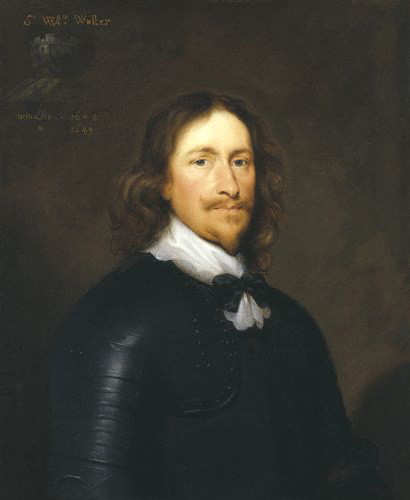The trained bands were, basically, the militia. Although “trained” seems to have sometimes been a slight exaggeration, they were organised and equipped and so an important resource in the lead up to Civil War, especially as there was no significant “national army” at the time. By far the most important were those of London, which had a significant effect on the course of the war. The trained bands in Kent were much smaller, but they did have the advantage that, unlike those of some counties, they could be deployed outside their county.

William Waller
The situation in Kent
Kent was a deeply divided county in the Civil War. Although
nominally under Parliamentary control, there were risings in Tonbridge and
Sevenoaks in 1643 (see an earlier blog), Canterbury in 1647 and a major uprising in 1648, culminating
in the Battle of Maidstone. The Trained Bands however remained firmly in Parliamentary
control, even in 1648, and formed part of the Southern Association under Sir
William Waller (who was born in Knowle House in Sevenoaks in Kent).
Organisation
The Bands were organised into “lathes” or areas, a system
unique to Kent and possibly dating to the time when Kent was an independent
kingdom1, which might also explain the naming system, as even a
cursory glance at a map shows that these are not the most significant places in
Kent, and nor were they in the 1640s. Anyway, there were five in total,
basically dividing the county north to south. Working from west to east;
Sutton at Hone – adjoining London, including Blackheath,
Bromley, Dartford and Westerham
Aylesford – from Chatham and Rochester in the north to Tonbridge in the south, with the county
town, Maidstone.
Scraye – a more rural area, though including Ashford and
Faversham. Parts of the Lathe seem to have been strongly Baptist, with in 1670
800 people attending a meeting at Egerton.
St Augustines – Canterbury, and the north Kent ports of Dover,
Deal and Sandwich
Shepway – the south Kent ports of Folkestone, Hythe and
Romney.
Each area was supposed to supply militia, as well as “auxiliaries”
“volunteers” and “Horse”, ie, cavalry. Note, most of what appears below is from
the excellent BCW Project site at www.bcw-project.org.
In 1638 the Kent Trained bands were recorded as having, in
total, 4,667 men, with 2,910 muskets and 1,757 corsets (ie. armour for the
pikemen) as well as 293 horse. Unfortunately, their equipment was severely
criticised just the next year, as many of the muskets didn’t work and the pikes
were rotten!
Active history
In 1639 each of the Lathes contributed to a force to be sent
north for the ill fated Bishops War in Scotland, 998 men in total. They went by
sea, assembling at Gravesend and traveling on naval vessels supplemented with
colliers to Harwich where they picked up men from the Essex Trained Bands and
sail for Scotland where they were all combined into Sir Thomas Morton’s Regiment
of Foot. Perhaps fortunately given the state of their equipment, they were not
tested in battle, just occupying the islands of Incholm and Inchkeith, but the
regiment did lose 100 men to smallpox.
In 1640 each of the Lathes contributed to a force to be sent
north for another “Bishops War” in Scotland, 700 men in total.
In the Civil War Kent was officially on the Parliamentarian
side, with placemen in most of the important positions in the county and the
Kent Trained Bands forming part of the Southern Association under Sir William
Waller.
Aylesford Lathe – the Trained Band was initially under Colonel Sir
Francis Barnham (the MP for Maidstone) and later Colonel Mark Dixwell, and took
part in the Siege Arundel in 1643/4. The Volunteers under Colonel George Newman
are recorded at the Second Battle of Newbury in 1643. The Horse may have work
blue as they are recorded in 1599 being issued with “cassocks” of this colour.
St Augustine Lathe – under Colonel Sir George Sondes at the
start of the war, though he was a Royalist and was later imprisoned and lost
much of his estate. He flourished after the restoration and was made Earl of
Faversham. His Colonel of Horse, Sir Richard Hardress was initially on the
Parliamentarian side and was at the Siege of Arundel, but later he joined the
Royalist uprising in 1648. In contrast, the Volunteers were used to put down an
uprising in Canterbury in 1647 (their home patch) and one company of the auxiliaries
was in garrison in Canterbury in 1648.
Scraye Lathe – under the elderly Sir Edward Hales at the start of
the war, the trained band took part in the Siege of Arundel, as did the
volunteers under Colonel William Herbert and the Horse. Hale’s grandson was a
Royalist and raised a regiment of Horse for the 1648 uprising.
Shepway Lathe – under Colonel Sir Humphrey Hales. The Horse at
least were at the siege of Arundel.
Sutton at Hone Lathe – under Sir Francis Walsingham in 1639 and
later under Colonel Thomas Blunt. The Volunteers under Colonel Sir William
Brooke were at the Relief of Gloucester and later the First Battle of Newbury,
in 1643, as well as the Siege of Arundel in 1644. The Horse were initially
under Sir John Rivers, though he joined the Royalist uprising at Tonbridge in
1643 (see earlier blog).
1 See www.britishcountyflags.wordpress.com
No comments:
Post a Comment